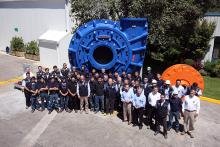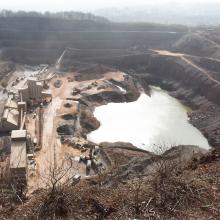Weir Minerals is sharing its considerable knowledge of how to identify potential equipment failures before a costly breakdown occurs.
The Top 10 Warning Signs website page and video available for viewing on global.weir highlights the importance of regular maintenance routines, and outlines what equipment operators should look for in order to spot when maintenance may be required.
The blog was put together by
In his blog, John explains how processes in mining operations unavoidably expose equipment to substantial wear and tear. The efficiency and reliability of minerals processing equipment feeds directly into the bottom line of any mining or quarrying operation. Low output, high power or fuel consumption, over-spending on replacement parts and avoidable downtime are all symptoms of a poorly maintained process.
The key to ensuring process equipment operates at its optimum standard is regular monitoring and maintenance of wear parts. His blog recommends a condition-monitoring system – a service offered by the majority of quality equipment suppliers – that logs key performance data so that work can be scheduled at the most convenient time.
He added: “The warning signs are a checklist of the most critical factors affecting the performance of equipment on site. The most important consideration in ensuring the reliability of your operations is choosing a quality manufacturer which can also offer the appropriate aftermarket support, providing through-lifecycle peace of mind and continued lower ownership cost.”
Weir Minerals top 10 warning signs that may indicate that equipment is ready for maintenance or repair are:
1.Excessive leakage. Linings inside slurry-handling equipment such as pumps and cyclones are designed not only to keep liquid inside the system, but also to promote low-turbulence and efficient flow. Excessive leakage could be a sign that the liners are worn and are ready to be replaced.
2.Increased power consumption. Excessive or sudden increases could be a sign that the machinery may need attention.
3.Bearings. The bearing assembly in any rotating equipment is fundamental to a successful operation, and signs of problems include increased temperature, noise or shaft movement. Routine monitoring, maintenance and lubrication are essential.
4.Vibration. Vibration is expected in some process equipment such as screens but this is not the case in pumps, where an increasing level of vibration is a sign of inefficiency. Bearing assembly or poor drive-belt alignment could be behind it, so it is wise not to ignore the issue.
5.Poor belt tension and alignment. Pump performance is often compromised by poorly-tensioned and aligned systems. Not only will this mean belts need to be replaced more often, leading to unnecessary interruptive maintenance, but it could also be compromising the efficiency of the bearing assembly.
6.Slurry leaks from pump gland seal. Slurry leaking from the seal could be a sign that it is compromised and the packing needs replacing.
7.High wear-parts turnover. When parts such as pump impellers and cyclone liners need to be changed very frequently, the whole system should be reviewed and an upgrade to the equipment may be worth the investment. Improved hydraulic designs or higher quality wear-resistant materials more suited to the application could significantly increase the longevity of wear parts.
8.Uneven wear patterns. If patches of rapid wear appear in worn-out parts while other areas remain little affected, it is a sign that wear parts are being used up too quickly because of turbulence in the system.
9.Reduced flow rates. Keeping track of the throughput of your main process equipment is a vital part of an effective proactive maintenance strategy. If flow rates begin to fall on part of the system, this could create a bottleneck in the whole process.
10.Low mean time between failures. This is arguably the surest sign that either your equipment is not up to the task it is handling, or that your maintenance programme is not suitable for the purpose it has been assigned. Improving the mean time between failures through careful specification and effective maintenance has the potential to boost the financial performance of the process.
An animated video has been created which has been translated into eight different languages, including French, German, Polish and Czech.
To see the blog in full, please visit: %$Linker:







